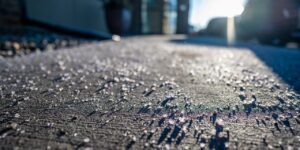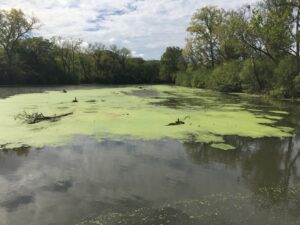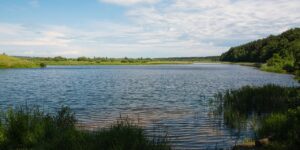Troublesome wet spots in your yard? Native plants can help! Plant native trees and shrubs in the low-lying parts of your property that collect rainfall. These trees and shrubs soak up the water pooling on the surface and infiltrate it into the soil. At the same time, native trees and shrubs are a positive force for the environment by reducing stormwater runoff and providing food and habitat for local wildlife like birds and butterflies.
In this blog post, we’ll look at trees and shrubs native to northern Illinois that can tolerate wet conditions.
5 Trees and Shrubs for Wet Areas
Pagoda Dogwood, Cornus alternifolia
Pagoda dogwood is a large shrub or small tree that works well as a landscape tree around homes. It has attractive white flower clusters in the spring that are beneficial to many kinds of pollinators. The flowers turn into small berries that nourish native birds.
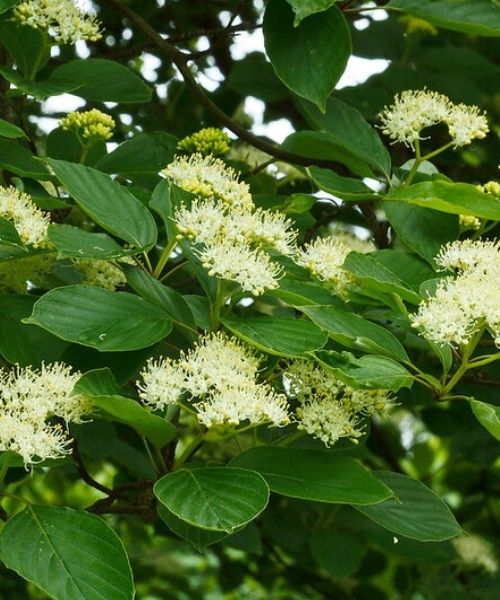
“Cornus alternifolia” by
Tom Potterfield licensed under CC BY-NC-SA 2.0 Deed.
Light exposure: prefers partial sun/shade, adapts to full sun and light shade
Soil conditions: moist, well-drained
Mature height: 15-25 feet
Mature width: 20-30 feet
Bloom color: cream or white
Bloom time: May, June
Find more details about Pagoda Dogwood here.
Buttonbush, Cephalanthus occidentalis
Buttonbush is a moisture-loving shrub with unique spherical flower clusters. Butterflies and other pollinators love buttonbush’s fragrant flowers. After blooming, the flowers become red, ball-shaped fruits. Buttonbush tolerates wet soil and even shallow standing water.
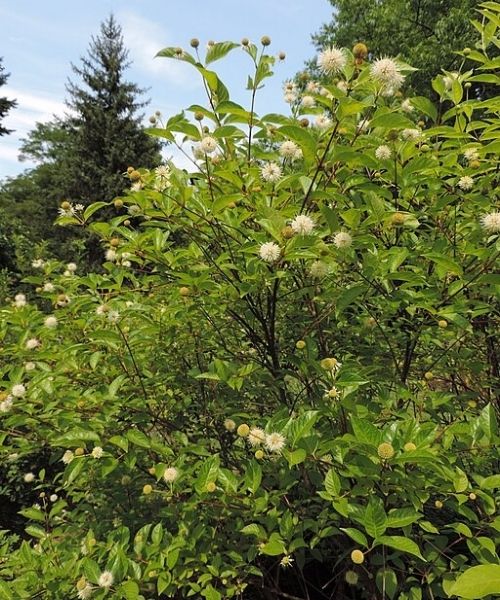

“Cephalanthus occidentalis” by Kenraiz Krzysztof Ziarnek licensed under CC BY-SA 4.0 via Wikimedia Commons.
Light exposure: full sun or partial sun/shade
Soil conditions: moist to wet soil
Mature height: 5-12 feet
Mature width: 6-8 feet
Bloom color: white
Bloom time: June
Find more details about Buttonbush here.
Swamp White Oak, Quercus bicolor
Swamp white oak grows to be a large tree, and like the name suggests, it can tolerate occasional flooding and wet sites. Being a native oak tree, swamp white oak offers a variety of environmental benefits. Its leaves are a vital food source for caterpillars, which attract native birds seeking sustenance. The oak’s acorns provide nourishment for wildlife, including birds and mammals, fostering a thriving ecosystem within your yard. Additionally, an oak tree’s large root system is excellent at infiltrating stormwater into the ground.


“Quercus bicolor” by James St. John licensed under CC BY 2.0.
Light exposure: full sun
Soil conditions: moist, well-drained soil
Mature height: 50-60 feet
Mature width: 50-60 feet
Find more details about Swamp White Oak here.
Hackberry, Celtis occidentalis
Hackberry is a native tree and is easily identified by its irregular, ridged bark. It can adapt to a variety of soil conditions, including wet soils. Its leaves are food for caterpillars and its small, brown-purple fruits are food for birds.
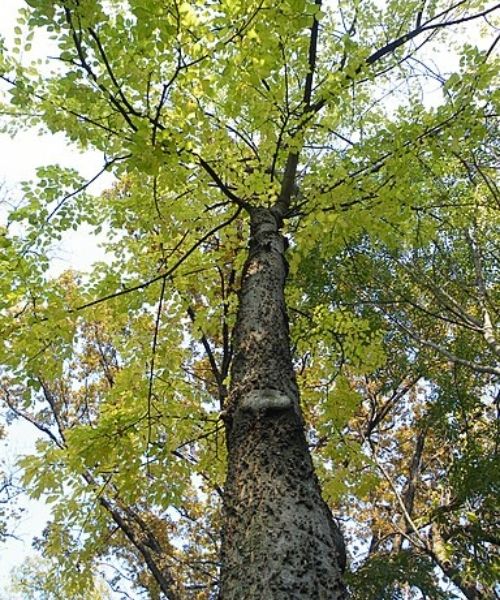

“Celtis occidentalis” by Marija Gajić licensed under CC BY-SA 4.0 via Wikimedia Commons.
Light exposure: full sun or partial sun/shade
Soil conditions: moist, well-drained soil
Mature height: 40-60 feet
Mature width: 40-50 feet
Find more details about hackberry here.
Blackhaw Viburnum, Viburnum prunifolium
Blackhaw Viburnum is a large, multi-stem shrub with white flower clusters. It’s also a source of interest in the fall when its leaves turn orange to deep red. It can tolerate a variety of planting sites, including dry or wet areas and sun or light shade.
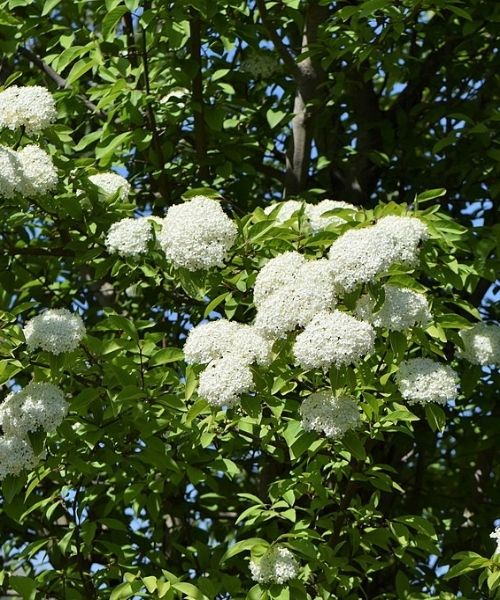

“Viburnum prunifolium” by Kenraiz Krzysztof Ziarnek licensed under CC BY-SA 4.0 via Wikimedia Commons.
Light exposure: full sun or partial sun/shade
Soil conditions: moist, well-drained
Mature height: 12-15 feet
Mature width: 8-12 feet
Bloom color: white
Bloom time: May, June
Find more details about Blackhaw Viburnum here.
5 Trees and Shrubs for Wet Areas
The demand for native plants is growing, yet it is not always easy to find native plants for sale. A few suggestions for sourcing native plants include:
- Local native plant sale events: The Conservation Foundation and Forest Preserve Districts hold annual native plants, typically in the spring. Chicago Living Corridors updates a list of native plant sales in the Chicago region each year.
- Select nurseries and garden centers: Natural Garden Natives is the native plant brand of Midwest Ground Covers. They have a store locator of garden centers that stock their plants.
- Online native plant retailers: Possibility Place and Prairie Moon Nursery are reputable native plant nurseries that ship plants. natura
From attractive shrubs like Pagoda Dogwood to steadfast trees like Swamp White Oak, native trees and shrubs can be the solution to problem wet areas in your yard and benefit the ecosystem at the same time.
Information about these trees and shrubs was sourced from Illinois Wildflowers, Morton Arboretum and Midwest Groundcover websites. Check out these websites for more great information about plants native to our region.


